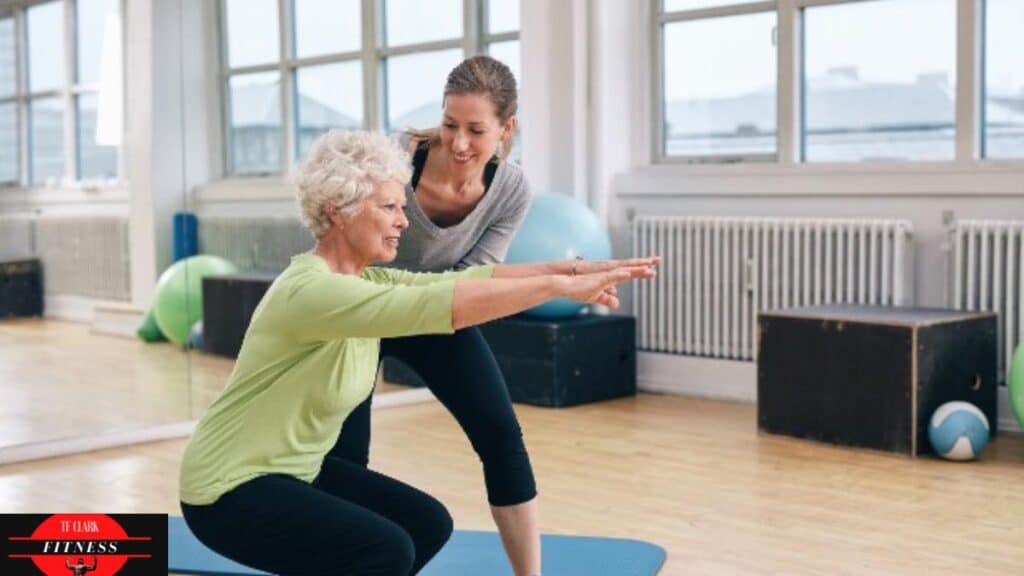In the demanding role of a caregiver, proper care of the caregiver and the person under one’s care is essential. While caregivers usually choose others’ needs, their health is critical and cannot be neglected. By incorporating fitness as the key element of their everyday lives, they will be able to rise to the expectations of providing the best services. With regular exercise, stress management, and self-care techniques, caregivers strengthen their health physically and mentally to overcome their predicaments.
Also, healthcare education classes train caregivers with relevant knowledge and skills that help them improve the quality of care they provide. Combining health and fitness education in their everyday life will give power to caregivers, allowing them to take charge of their lives and be healthy. This integrative approach strengthens individual resilience and is crucial for assistance.
Giving profound quality support becomes possible for a caregiver when they prioritize fitness. Here’s how:
Being Aware of the Significance of Informal Caregivers.
Caregivers define a role in society on multiple levels, offering assistance to people who can no longer care for themselves due to old age, an illness, or a disability. Among their tasks are helping with daily living (ADLs) such as bathing, dressing, and mobility, ensuring drugs are taken correctly, and setting up medical appointments.
Along with performing routine duties, caregivers play an important emotional role, providing companionship, consolation, and comfort to create welcoming surroundings. From this emotional factor, trust and mutual respect, there is love between the caregiver and care recipient, which makes a care recipient feel safe and secure.
Moreover, caregivers play a role as connectors, bridging the communication gap and channeling the advocacy of healthcare providers, family members, and support networks to meet the care recipient’s needs. This necessitates the maintenance of patience, compassion, adaptability, and resilience as caregivers face the issues and deal with stress and emotions in the process. Indeed, it is pretty challenging yet fulfilling. It magnifies the commitment to the health of those in need.
The Importance of Physical Fitness for Caregivers
• Boosting Strength and Endurance
Usually, caring requires muscles and energy, such as lifting, transferring, and helping with mobility. Insufficient strength and endurance may hurt caregivers since they are in danger of injury, strained muscles, or fatigue, preventing them from providing quality care.
Regular exercise routines, including strength training, cardiovascular endurance, and flexibility, foster the physical resilience required to provide competent caregiving. Strength training exercises: Weights or resistance bands build muscle strength and resistance. Cardiovascular exercises like walking, swimming, or cycling maintain heart health and boost stamina in the long run, enhancing energy levels when caregiving.
Exercises focusing on caregiving muscles, such as the legs and back, help prevent injury. Proper lifting techniques and body mechanics boost safe caregiving practices. Regular exercise ensures caregivers maintain the resilience to provide optimal care while prioritizing their health.
• Promoting Long-Term Health
Prioritizing physical fitness provides caregivers with many significant long-term health advantages. Regular exercise minimizes the risk of chronic health problems like heart disease, diabetes, hypertension, and obesity, which are common among caregivers whose responsibilities may be stressed.
Regular physical activity in caregivers reduces the risk of developing chronic health conditions and enhances health outcomes and quality of life. Physical activity helps in weight control, blood pressure regulation, cholesterol normalization, and immune system improvement, all of which benefit overall health and quality of life.
Additionally, physical activity is a powerful stress management tool that assists caregivers in dealing with emotional and psychological pressures. Workouts stimulate the production of endorphins, the neurotransmitters responsible for happiness and emotional well-being, lowering the level of stress, anxiety, and depression common among caregivers.
Mental Well-being and Its Connection to Caregiving
• Stress Management
Providing care involves taking physical responsibility and coping with emotional and mental stresses. Caregivers are constantly being pulled in different directions to deal with responsibilities, uncertainties, and complex emotions, leading to high-stress levels among caregivers. Long-term stress can lead to burnout, anxiety, depression, and other Mental health problems, both the caregiver’s physical and psychological health and ability to provide support.
Physical exercise is the most effective way for caregivers to cope with stress and become emotionally intense. Exercise causes the body to produce endorphins, natural mood enhancers, and pain relievers, making you feel less stressed and less anxious and lifting your mood. Furthermore, regular physical activity builds the body’s ability to combat stressors in the long term, thus improving resilience.
Weaving mindfulness skills like deep breathing, meditation, and yoga into physical exercise provides a platform to augment stress management practices. Mindfulness helps us develop awareness, acceptance, and focused attention in the present moment, which lessens overthinking and promotes serenity amid caregiving upsets.
Caregivers take advantage of physical activity and mental health awareness to teach themselves practical strategies for managing stress and caring for others with resilience.
• Improving Cognitive Function
Improving cognitive function is crucial for caregivers navigating complex situations, thus providing the best possible care to their loved ones. An exercise is critical for enhancing cognitive skills, providing caregivers with a front-loaded strategy for sustaining their mental discernment and flexibility in their duties.
Daily exercise has been shown to enhance memory, attention, and problem-solving capabilities, which are essential elements of positive care provider outcomes. Brain exercise promotes neuroplasticity and cognitive flexibility, thus improving brain health. It enhances blood flow to the brain, delivering oxygen and nutrients essential for cognitive functioning.
In addition, physical activity triggers neurotransmitters like dopamine and serotonin, which are necessary for mood regulation and cognitive performance. Moreover, getting into things that make sense, like puzzles and learning new skills, plus the advantages you gain from physical exercise, are complementary. These challenges catalyze neural bonds, enhancing mental sharpness and strength.
A more helpful outcome is achieved by adopting a broad approach that integrates physical activity and cognitive stimulation, enhancing cognitive abilities.
Balancing Caregiving Responsibilities with Personal Wellness
• Time Management
Effective time management is vital for caregivers to manage their responsibilities without compromising their wellness. Managing several tasks during the day may be quite daunting. However, incorporating fitness into your daily routine, even with the stresses of caregiving, is possible with a bit of thought and sacrifice.
Identifying moments when physical activity can take place is of critical importance. Finding time to move is plausible, whether between caregiving tasks, early mornings, or evenings. Splitting exercising into smaller components, for example, short walks or simple routine practices, helps fit physical activities into busy days.
The involvement of the care recipient in activities fosters interaction and mastery over mutual well-being. Simple activities such as walking together, joint physical exercise, or recreation can improve social interaction and caregiving relationships between caregiver and care recipient, helping them live better lives together.
• Self-Care Practices
Prioritizing self-care practices is vital to caregivers’ well-being and helps prevent burnout. Self-care embraces actions focusing on physical, mental, and emotional well-being, allowing caregivers to replenish their energy reserves and remain resilient.
Self-care routines promote a sense of wholeness and well-being in being a caregiver. It could involve finding time during the day for things you enjoy and find relaxing, such as reading, hobbies, or spending time outdoors. Self-care is not indulgent but necessary for one’s overall health and ability to care for others.
As a result, individual practices are not the sole means of support since support can also be sought from friends, family, and broader networks. Connecting with people who have been through the same thing lets you know you are not alone and that others understand what you are going through. They give you comfort, empathy, and practical help. Building a support system in this way helps foster resilience and remind caregivers that they are not alone.
Building a Support Network
• Community Resources
The caregivers need to have a robust support system to manage issues effectively. Within the family and friends, going out into the community can give access to required information and practical help. These resources involve diverse services and organizations aiming to assist caregivers and ensure a favorable experience.
Community services provide personalized counseling on caregiving, including medical information, legal advice, respite care options, and support groups. Caregivers will find these resources helpful in gaining insights, connecting with peers, and accessing specialized services. From caregiver education programs to hotlines, community resources aim to share knowledge, tools, and emotional support needed along the caregiving journey.
Further, community resources have the added advantage of online forums, social media groups, and local events that allow for experience sharing and seeking advice. Through involvement with these resources, caregivers can create networks, broaden their support groups, and obtain the tools needed to survive their roles.
• Family and Friends
Strengthening social support through family and friends is essential for caregivers to manage their roles. Effective communication and well-articulated roles are necessary in this network to promote a supportive environment and avoid conflict.
Communication channels provide carers with ways to articulate their needs, fears, and boundaries. Clarifying the duties among the family members and friends helps the primary caregiver share the burden. Ensuring tasks are distributed according to strengths and availability encourages teamwork and owning responsibility, thus creating unity within the support system network.
Keeping up the relations and contacts with family members and friends brings emotional support and company for the caregivers. Check-ins and supportive conversations provide caregivers with a feeling of purpose. As a result, these ties are nurtured and create a solid supporting system that will sustain care providers through challenges with care and compassion.
The Ripple Effect of Prioritizing Fitness
• Setting a Positive Example
When caring for others, prioritizing fitness allows a healthy lifestyle that can ripple effect on others adopting good health habits. Caregivers establish good leadership when they give priority to their well-being. It serves as a role model to care receivers, families, and the community; being fit is the caregivers’ evidenced commitment to improving their physical health. Setting an example to others will make them prioritize wellness and create a positive health environment.
Developing a positive example is a good way of encouraging the care recipients to participate in physical activity and adopt healthy choices. Caregivers setting the tone of self-care and resilience conveys that health is possible through difficulties. The influence is not only limited to caregiving but also affects the peers as they adopt positive behaviors and embrace wellness practices.
In addition, prioritizing fitness builds a sense of community in the caregiving team. We look for common areas to discuss, such as sharing experiences, tips, and successes in fitness endeavors to create a supportive environment where caregivers can encourage and uplift one another. The resulting shared encouragement validates the importance of the caregiver’s health through and beyond the caregiving journey.
• Enhancing Quality of Life:
Regular physical movement of caregivers can dramatically improve caregivers’ quality of life. Along with physical health benefits, exercise enhances cognitive function and emotional well-being, creating a better caregiver experience and fostering resilience. Physical exercise can aid in coping with stress and anxiety; hence, caregivers may handle emotional challenges better.
Exercising is essential for self-care and relaxation. Taking time to be involved in physical activities increases physical health and enables caregivers to refuel mentally and emotionally. Whether it is a brisk walk, yoga class, or a gym workout, caregivers can rejuvenate mentally and emotionally, safeguarding balance and perspective while facing the demands of caring.
Integrating physical activity into the caregiving routine increases autonomy and control over one’s life. Caregivers who exercise regularly show resilience and self-confidence in handling their responsibilities. These proactive actions ensure the caregiver’s quality of life and positively impact the care recipient by creating an environment suitable for nurturing the care recipient.
Embracing Wellness: The Path to Caregiver’s Satisfaction
First of all, the healthiness of the caregiver has to be prioritized since it is the greatest pre-condition for the caregiver to provide quality care. Caregivers strengthen themselves holistically by integrating physical effort and caring for themselves, paving the way for a better future for themselves and others.
Take responsibility for your health now and start taking steps that will put you in a position to care for others and pass on practical and compassionate support—your wellness should be essential to you. Start prioritizing fitness to ensure you have the stamina and energy required for excellent care. Find your well-being fundamental to having positive experiences and impacts that will be felt forever.




